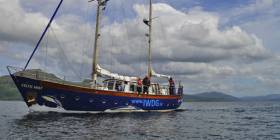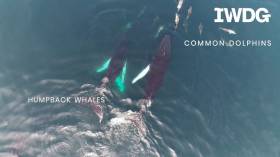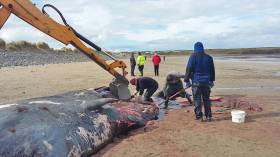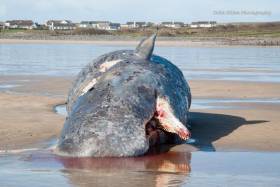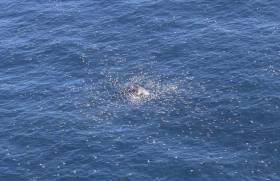Displaying items by tag: IWDG
Dolphin Encounter In Tralee Bay Too Close For Comfort
O’Sullivan’s Marine have shared with us a photo of the surprise moment when a dolphin landed on the bow of one of their boats.
The sudden encounter was all the more startling as the marine mammal almost knocked a child out of the boat — but the youngster still managed to capture the cetacean on camera.
Elsewhere, BreakingNews.ie reports that a striped dolphin was found dead in a river near Lahinch despite the best efforts of local surfers after the animal live-stranded on the popular North Clare beach.
Dr Simon Berrow of the Irish Whale and Dolphin Group, who also joined the rescue effort, said: “We found a striped dolphin, quite a large animal, obviously in distress. We tried to push it out again [to sea] but it was very weak.”
The IWDG chief added: “The surfers did their best and we thank them for trying but sometimes a dolphin will live strand themselves … there’s very little you can do.”
Sixteen years after the Irish Whale and Dolphin Group’s (IWDG) first attempt to find the origins of Ireland’s humpback whales, a chance excursion on the latest expedition to Cape Verde has finally revealed the breeding grounds for these threatened marine wildlife visitors.
It was long suspected that the waters around the island chain off West Africa were the most likely breeding area for humpbacks that have been sighted nearly 1,000 times and photographed ever 100 times in Irish waters over the last two decades.
But that wasn’t confirmed until this April during a two-week expedition, when on a trip to a known breeding spot in Santa Monica off Boavista, IWDG chief Simon Berrow photographed two humpbacks that surfaced near his boat.
One of these whales was identified by the group’s international network of experts as an individual sighted by Nick Massett off Kerry four years ago. It was just the match they’d been searching for.
“What a fantastic outcome for the IWDG,” said Massett at the news. “It was born out of the belief that the Cape Verde islands was the breeding ground for the humpbacks we have documented here off Ireland. But it is down to the dogged persistence of the expedition teams that have returned there over the years to prove the theory.
“I am delighted for Simon Berrow that he finally got the definitive proof of this connection, and pleased to have played my part in documenting the animal here off Co Kerry.”
Also celebrating the achievement was IWDG sightings officer Pádraig Whooley, who had been beginning to doubt whether they had been looking in the right place all these years.
“We’ve finally found a really important missing piece of the jigsaw,” said Whooley, “but it’s a very large puzzle, which still has lots of missing pieces.”
The next steps for the IWDG are to determine how to use this information to enhance conservation for the endangered species, perhaps involving a greater level of co-operation between the Irish and Cape Verdean governments.
Meanwhile, the group will follow-up this find with another expedition to Cape Verde this coming September.
Sightings of an unusual looking bottlenose dolphin off the East Coast in recent weeks have turned out to be a Scottish scrapper named Spirtle.
Images of the dolphin seen off South Dublin and North Wicklow earlier this month showed what appeared to be heavy scarring and discolouration on its right flank.
That was enough for Dr Joanne O’Brien of the Irish Whale and Dolphin Group (IWDG) to identify the animal as the daughter of a dolphin well known in the Moray Firth.
Spirtle’s story is one of survival as almost three years ago to this day, she was found live stranded with significant injuries and suffering severe dehydration.
Since then she’s bounced right back from the brink of death, and it appears she’s now even at the lead of a group of bottlenose dolphins that’s made its way south along the Irish Sea beyond Dublin Bay.
A rare sighting of a different kind was made in West Cork this past week, where a charter boat operator witnessed what he believed was an attack on a pod of common dolphins by a killer whale.
David Edwards was 15 miles south of Galley Head last Tuesday (21 May) when he saw the orca chase after its fellow cetaceans for its lunch — and his images of the event have been confirmed by IWDG sightings officer Padraig Whooley.
Echo Live has more on the story HERE.
A group of Ireland’s environmental NGOs are teaming up this spring for a rather unique education project lead by the Irish Whale and Dolphin Group. The exciting Floating Classroom initiative is combining ocean exploration with an educational schools programme which aims to raise awareness of Ireland’s marine biodiversity. Taking to the seas in the IWDG’s research vessel Celtic Mist, the team of marine biologists and ocean literacy experts will be making their way down Ireland’s south-east coast from Arklow to Cork, calling into coastal communities providing engaging workshops to schools along the way.
After an extensive refit during the winter in Grand Canal Docks, Dublin, the 56-foot ketch yacht will also be open to the public when docked at local marinas and harbours, giving the public an opportunity to see the workings of a dedicated whale and dolphin research vessel and how researchers live and work at sea.
Apart from raising awareness for Ireland’s rich marine wildlife, the team will be emphasising the importance of taking care of our seas and oceans. With challenges such as plastics pollution, climate change and biodiversity loss now frequently in the news, there is a pressing need for communities to work together to tackle environmental issues.
While pupils will be introduced to the wealth of marine and coastal wildlife on their doorstep, each school will be asked to come up with three ways in which they feel they can make a difference for their local blue environment.
The team of biologists will also be proposing ways in which the public can get involved, including citizen science projects that encourage people to report their sightings of whales, dolphins, seabirds and even shark eggs! Schools will be encouraged to get involved in other community-based initiatives too, such as beach cleans being run by organisations in their area.
Environmental NGOs involved in the Floating Classroom include the Irish Whale and Dolphin Group, Marine Dimensions, the Irish Wildlife Trust and the Irish Ocean Literacy Network. Funding for the Floating Classroom has been kindly received by the Irish Environmental Network through their Capacity Building Grant.
Whale watchers have captured spectacular aerial video of a group of humpback whales spotted “socialising” off West Cork.
The Irish Whale and Dolphin Group’s science officer Seán O’Callaghan filmed the remarkable scene last month just days after the first humpback whale sighing of the year was made in the same region, sailing out of Reen Pier.
“We had perfect sea conditions to search for cetaceans (whales, dolphins and porpoises) but our efforts to spot distant large whale blows were hampered by Saharan sand that caused a thick haze at sea,” the IWDG said.
“However, we did connect with up to six humpback whales feeding and socialising in offshore waters which allowed us to collect the first set of aerial images and video that will be used to estimate the length and body condition of these iconic giants.”
The video shows four of the humpback whales interacting with each other while common dolphins swim just ahead and among them.
And it marks the first significant contribution to WhaleTrack Ireland — the IWDG’s new drone-based citizen science project, supported by Ryanair, which aims to find out what these and other marine wildlife giants are doing within and beyond Irish waters.
IWDG Takes Samples From Sperm Whale In Sligo As Unusual Strandings Remain Unexplained
#MarineWildlife - A team from the Irish Whale and Dolphin Group (IWDG) was on site at Streedagh Strand in Sligo yesterday (Thursday 4 April) to investigate the third sperm whale stranding in a matter of days along Ireland’s West Coast.
As reported yesterday on Afloat.ie, the discovery of a third such whale carcass made for an “increasingly unusual stranding pattern”.
While sperm whales are relatively abundant in Ireland’s deep ocean waters, they are rarely found above 300 metres — and male specimens are far more common than the female whale found in Sligo.
The IWDG confirmed that samples were taken from the 10.4m carcass, which showed “no obvious signs of ship collision [or] entanglement, nor was the whale emaciated”.
Examination of stomach contents found no plastic debris and few food remains.
“So as is so often the case with strandings, we know more about what didn’t kill the whale than what did kill it,” the IWDG stated — adding that it is liaising with Scottish colleges after a decomposed sperm whale was found on Uist in the Outer Hebrides, due north of Ireland, in recent days.
The group also notes that multiple warships and submarines are involved in Nato’s annual Joint Warrior exercise ongoing west of the Hebrides.
Sonar activity from military vessels has been suggested as a cause of whale strandings throughout Europe in recent years, including a major event across Scottish and Irish waters last year.
“However, these whales have been dead for one to two weeks so this can’t explain these strandings, unless some active equipment was tested offshore prior to the start of this exercise,” the IWDG says.
#MarineWildlife - A third sperm whale stranding on Ireland’s west coast within just a few days is now a cause for concern, the Irish Whale and Dolphin Group (IWDG) says.
Following the discovery of two sperm whale carcasses on the same day last week — in Donegal and west of the Aran Islands, the latter believed to have beached in Connemara — a third was found washed up on Streedagh beach in Sligo at the weekend.
Images of the latest stranding suggest it is an adult female, which the IWDG describes as “a little unusual” as “generally we get adult male sperm whales off the Irish coast”.
The close proximity of the strandings is also “now a concern”, though no cause of death has yet been determined, and plastic pollution is unlikely to be the culprit.
The IWDG added it “will explore some potential options regarding this increasingly unusual stranding pattern”.
Meanwhile, RTÉ News reports that the Galway council officials hope the sperm whale carcass washed ashore in Connemara will be taken out by high tides in the coming days.
UK’s Natural History Museum Releases Decades Of 20th Century Whale & Dolphin Stranding Records
#MarineWildlife - The UK’s Natural History Museum has made available for the first time a vast trove of whale and dolphin stranding records in British and Irish waters.
The data covers the years 1913 to 1989, filling in a significant gap before the Irish Whale and Dolphin Group’s stranding scheme began in 1991.
Over the years many entries were submitted by the coastguard, fishermen and members of the public — including a detailed record of a harbour porpoise found in Co Cork in 1913, the very first card in the data set.
PhD candidate Ellen Coombs is combing through the records to determine what picture “one of the longest systematic cetacean stranding data sets in the world” reveals for the status of cetacean species in our waters.
And already there have been some important finds, such as occasional records of deep-diving Cuvier’s beaked whales over the decades — not to mention a double stranding of narwhals in 1949.
The data also correlates with already known trends, such as the sharp decline in blue whale records with the expansion of commercial whaling in the early 20th century.
The Natural History Museum website has more on the story HERE.
Two Sperm Whale Carcasses Found In Ireland On Same Day
#MarineWildlife - The remains of two sperm whales have been spotted around Ireland in recent days.
The first was sighted in the Atlantic Ocean some 100km west of the Aran Islands on Monday (25 March) by an Air Corps airman.
Later that same day, samples were taken from a 43ft sperm whale carcass found washed ashore at Magheroarty in Co Donegal. Highland News says it it thought to have been dead for a number of weeks.
Sperm whales are the largest predator in Irish waters and are relatively abundant in deep ocean but are rarely found above 300 metres, according to the Irish Whale and Dolphin Group.
The IWDG adds that a recent study estimated there are 3.2 sperm whales per 1,000 square kilometres of Irish waters.
Whale & Dolphin Strandings In Cork This Week ‘Only A Percentage Of What Is Actually Dead At Sea’
#MarineWildlife - Unusual weather for this time of year may be responsible for a recent spate of whale and dolphin strandings on the Cork coast in the past week.
The Irish Examiner reports that among the eight strandings were the carcass of a sperm whale on Long Strand in West Cork and a dolphin with fishing line around its beak in Schull.
However, the Irish Whale and Dolphin Group’s (IWDG) Mick O’Connell said that while the statistic was high within such a short timeframe, it was not necessarily a mystery.
“We normally get the same thing every year,” said the IWDG stranding officer. “It is usually more in the southwest and west, but this year, I suppose we have had more southeast winds, which probably explains it.”
O’Connell added that the strandings are “only a percentage of what is actually dead at sea” — and that post-mortems may “shed some light in their deaths”.
The Irish Examiner has more on the story HERE.





























